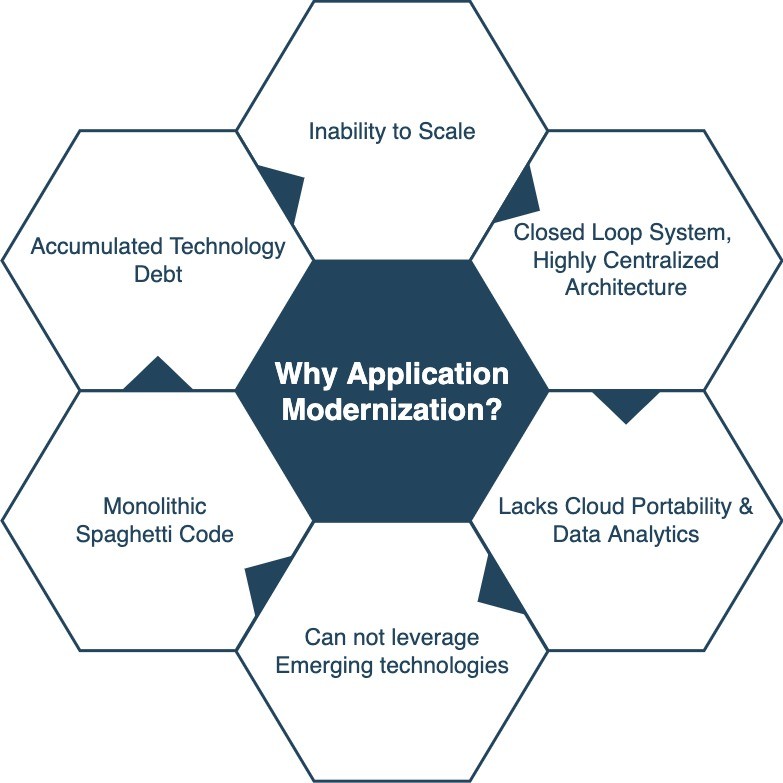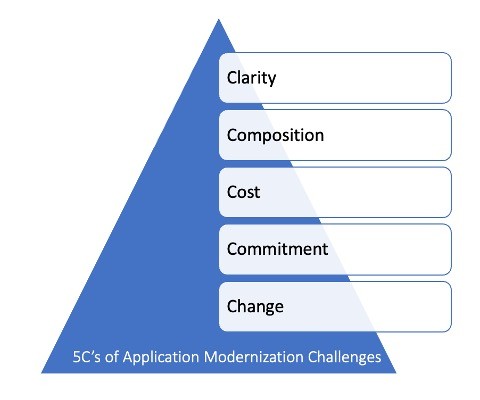Application Modernization, Simplified!

Application Modernization, Simplified!
Thinking about the Application Modernization is somewhat similar to renovating your old house with a structural and functional overhaul using latest tools and techniques, this is not a new concept since most of us have been dealing with it from the first application we deployed and hosted as part of constant evolution and keep it running and relevant. Today’s Application Modernization is critical part of the digital transformation vision and strategic approach to bring about changes in multiple fronts such as platform, framework, functionality, process workflows and/or interoperability with the legacy application etc. depending on the scope and priority the application modernization initiative might get road mapped into several sprints or phases to ensure minimal disruption to the stakeholders of the application.
Need for application modernizationThere are several factors that can drive the need of application modernization, the rational of this business initiative could be as simple as to survive among the existing competition and remain relevant to customers delivering new processes, features to handle and manage their interaction, provide enriched user experience via advanced technology platform. This also helps to keep an effective track of the entire lifecycle of any business, automate the workflows, proactively troubleshoots any faults, and thus meet and satisfy key stakeholder demands.
The legacy applications at times become barrier to business growth and pose security risks as technologies advance but application eco system can’t keep pace with this change and thus remains a constant challenge / risk to business in the following aspects..
- Inability to Scale – Legacy applications may provide limited scalability by design and architecture and thus becomes barrier to handle growth / increased usage or enrichment of functionality etc.
- Closed Loop System – often legacy applications are built as closed loop and might not be able to integrate with external systems and participate in new digital tools and services. Even customizing reports to accommodate new features and data points become highly complex and time consuming etc. major risk of closed loop systems or application is information security exposure and compliance readiness with changing regulations as well.
- Cloud Portability – Todays public clouds demand flexibility and API based service integrations as default feature of any application to consume cloud services and automation, the legacy applications have limitations to effectively use these value added services seamlessly unless they are reengineered. Same is the case with Data Analytics, the defined reports and data extraction methods of legacy applications often restrict the custom reports and sharing of data externally becomes challenging.
- Code reusability – The way legacy applications were programmed and compiled are drastically different from modern application frameworks and thus becomes monolithic unless broken down via functional modules or micro services to repurpose and reuse the common programming methods and structures, an ability to independently scale and interconnect within and outside the application perimeters is thus highly restricted. Use of The low code / no code ( Read, LCNC) platforms of today will be a distant dream.
Technology Debt – the code, configuration, base operating systems, databases, environments ( read, platforms) keep evolving as we see progressions in the emerging technology domain. The ability to harness these advancements and seamlessly patch or upgrade these parameters is key to the application agility and relevance, unless the application development team keeps refreshing the stack and associated toolsets in line with the code, applications remain rigid and will lose usability / constancy of purpose. The aging infrastructure might result in increased security exposure, slowness in response times or frequent disruptions and lower performance of these applications.

Depending on the business priorities and the executive sponsorship towards application modernization initiative there are few key strategies that will help operationaize or transform the applications. The step zero will be comprehensive assessment of the problems, available options and available resources etc to start with. This will entail identifying the characteristics, architecture, lifecycle, complexity of current application and regulatory compliance if any among many others factors, to determine the right approach and finalize the charter.
Before we discuss on the strategies of application modernization we must assess the current state of application and establish end goals since application modernization is a continuous process for augmenting the advancements such as platform, framework, functionality, process workflows as mentioned above. So the first logical step would be to perform and assessment or discovery of core characteristics and lifecycle of the application, its modularity i.e. reusability of the code , complexity / platform dependencies and finally the deployment architecture.
Assessment would lead to understanding and ascertain possible options or approaches to initiate the application modernization journey, they are..
- Application Migration / Encapsulation – the scope could range from porting legacy application software, database version updates or conversion, web-enablement or turnkey migration to a completely new operating system or platform or encapsulate the code for delivering new functionality that is coupled via modules or code that resides / operates externally. Version updates would be the first logical step even in the other two approaches listed below since application modernization warrants underlying platform to become current and may provide lease of life to existing applications. Many monolithic legacy on-premise applications were cloud-enabled via lifting and shifting approach. Although this approach or stage may involve minimal engineering of developmental efforts, terming plain lift and shift as modernization strategy might work may not be correct and may work as an interim measure, at times may result in adverse impact to the business on long run unless in-depth assessment reveals positive results and ensures practicality and endurance of the initiative.
- Re-Platforming, Re-hosting or Refactoring are the options when application is set to undergo lot of engineering and code changes to become cloud ready or redeployed on different hardware platform along with infrastructure configuration changes. Also few portions of the application code that interacts with the underlying platform may need upgrade, recompilation or redevelopment. This approach may result in faster cloud migration or adoption of distinct requirements of the new business logic to integrate with third party applications and deliver true value to our users with intended additional feature or functionality.
- Re-architecting approach needs a complete overhaul of the application, modularity to embrace newer engineering strategies and application architecture and may undergo major changes in code, configuration, databases and cloud computing areas. This approach would result in embracing latest toolsets for deployment, monitoring and support and leveraging distributed cloud computing metaphors as much as the code and configuration supports. The blend of old and new would exist in the same application and demands upskilling the resources while augmenting new technologies for the fact that these re-architected cloud-based applications would support future growth and portability more effectively.
- Rebuilding and Replacing the entire application is grounds up engineering exercise wherein current application is not at all touched or modified but a completely new application is designed and developed using similar scope of feature and functionality and deliverables as that of old application but enriched business workflows or logic running on latest platforms, DevOps frameworks, using modern databases, low code or no code methodologies etc. The migration efforts would only entail old master and transactional data from legacy application to this new cloud-native application to ensure data consistency and compliance of usage. End objective is that it delivers speed, scale, and security via agility, interoperability and enriched user experience by design as value add to the business and involves organizational changes and upskilling engineering teams to build, deploy and support such modern cloud-native application.
Any change would bring in resistance, discomfort and complexities to begin with, the purpose and preparation must look into few factors that can make or break this initiative, such as culture, environment and business value as key drivers to success the technological aspirations should be consequential so to say!
- Culture, the organization must embrace this change as the strategic engagement rather than dealing with it as a transactional operational project. The thought process, ability to transform and inculcate efficiencies and effectiveness as key performance indicators for each activity linked digitally, motivation for such change and sustenance of the day to day efforts etc are at play and will nurture the future. Application modernization will pave way as foundation for collaboration, participative decision making, simplification of business models and sustain continuous improvements in execution etc.
- Environment must become conducive to People, Processes and Technological interventions, the reforms would positively influence to identify and fix process inefficiencies, bottlenecks associated with the legacy applications reflecting legacy processes and mindsets. Application modernization should help simplify the solution and reduces risks and rigidity in the system, focus should be on retiring the age old processes, features and workflows that are no longer used or fail to deliver business value optimizing the application footprint to improve at ease and thus minimize time and money.
- Business value should be at the core and not the technology, the measures of success for application modernization should be business KPIs such as increased production efficiencies, profitability, customer acquisition, market share or increased revenue etc. to ensure constancy of purpose and clarity of objectives for application modernization, the technology adoption should just be means to reach and not the end result or goal. The true measures to retire or reinvent applications should be business value, utilization / usability, cost of ownership and technological risks/debt ( as impediment) this will dictate criticality and priority to road map the progression.
Application modernization is a journey and at times evolution that demand significant focus and clarity of the purpose. Today businesses have to deal with dynamics of profitability, market share and / or organic growth on business front and simultaneously ensure technological advancements and manage / mitigate risks arising out of technology debt or regulatory requirements / compliances. There are few tenets that can help make the journey safer and successful if the key stakeholder track these from various fronts such as people, process and technology, I collated them under five “C’s” of the challenges highlighted below..

- Clarity – Most of the large enterprises have many applications being used across multiple business fronts and managed internally or externally thus the body of knowledge ( technology, functional, operative aspects etc) is spread across many stakeholders and impact analysis of change in one of these application both in qualitative or quantitative way is grossly limited, any isolated decision would impact other applications and usability.
- Composition – While we discussed about the external application environment earlier, we must also look at the internal composition of the application, the way it was designed looking into the considerations, assumptions, relevance to scope or the state of operation, use of the software platforms and code originality written or any code that is embedded from third party or open source systems etc. This process will provide clarity on the complexity, estimated efforts and impact due to composition of various modules and components. Poorly designed and developed applications pose greater risk of high number of software bugs, vulnerabilities security exposure or even performance degradation unless proper code reviews, functional and integration quality checks are done with each release and versioning of the code and compiled deployment.
- Cost – Cost benefit analysis and constancy of purpose is key factor since application modernization may need large investments and considerable amount of time in case the scope of application modernization is significantly large impacting multiple modules and processes. With changing business dynamics and unforeseen situations the time, effort and funds may get adversely impacted due to overrunning priorities or unforeseen circumstances.
- Commitment - As mentioned earlier, the Cost is the key driver for business decisions today, since application modernization is a business leverage the need and purpose is obvious yet the ROI on the investment or benefits might not be visible as compared to the modernization costs being invested thus structuring some outcomes in the early stages of application modernization would inculcate confidence to the sponsors to remain committed.
- Change – The change is constant and needs reinforcement of the purpose and training of the stakeholders on usability of the features of new application while both applications co-exist, there might be overlapping of functionality, data and effort duplication in the interim phase. Similarly the change management should also address external users or beneficiaries to bring them up to speed on process or feature changes arising out of this initiative. The Change management overall must address all elements such as awareness, planning and communicating from beginning to the end of the initiative and ensure stakeholder \feel confident that the application modernization will be better and effective.
In Summary, Application modernization is one of the means to transform the digital experience for business stakeholders and positively influencing their digital wellbeing, more so creating new business value from existing applications or perhaps many are opting it for staying relevant or mitigating their at risk. It is now evident that application modernization enables the business, and has been a core element of the digital transformation agenda providing faster time to market products / service or subscriptions via digital channels, new revenue streams, expanding to newer markets and many more. Application modernization also becomes catalyst to adoption of data science unleashing power of data via insights and foresights, truly future-proofing the business!
***#Applicationengineering #Digitaltransformation #applicationdevelopment #digitalstrategy #Cloudnative #lowcodenocode #Cloudnative #Cloudonly #Applicationengineering